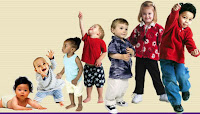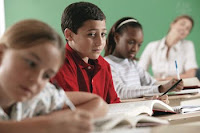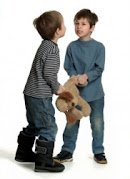“I’ve known for some time that something is not quite right with my child, and I’m starting to wonder if he has an autism spectrum disorder. What should I look for?”
 Learn the signs, and act early. Find out if your son’s development is on track, and learn the signs of developmental delays. Skills such as taking a first step, smiling for the first time, and waving "bye bye" are called developmental milestones. Kids reach milestones in how they play, learn, speak, behave, and move (e.g., crawling, walking, etc.). Track your son’s development and act early if you have a concern.
Learn the signs, and act early. Find out if your son’s development is on track, and learn the signs of developmental delays. Skills such as taking a first step, smiling for the first time, and waving "bye bye" are called developmental milestones. Kids reach milestones in how they play, learn, speak, behave, and move (e.g., crawling, walking, etc.). Track your son’s development and act early if you have a concern.
Here are the milestones that parents should look for if they are trying to track the possibility of an Autism Spectrum Disorder (ASD) in their child (ages 2 months - 5 years):
Baby at Two Months—
What most babies do at this age:
- Begins to act bored (cries, fussy) if activity doesn’t change
- Begins to follow things with eyes and recognize people at a distance
- Begins to smile at people
- Can briefly calm himself (may bring hands to mouth and suck on hand)
- Can hold head up and begins to push up when lying on tummy
- Coos, makes gurgling sounds
- Makes smoother movements with arms and legs
- Pays attention to faces
- Tries to look at parent
- Turns head toward sounds
Act early by talking to your youngster’s pediatrician if your youngster:
- Can’t hold head up when pushing up when on tummy
- Doesn’t bring hands to mouth
- Doesn’t respond to loud sounds
- Doesn’t smile at people
- Doesn’t watch things as they move
==> How To Prevent Meltdowns and Tantrums In Children With High-Functioning Autism and Asperger's
Your Baby at Four Months—
Your Baby at Four Months—
What most babies do at this age:
- Babbles with expression and copies sounds he hears
- Begins to babble
- Brings hands to mouth
- Can hold a toy and shake it and swing at dangling toys
- Copies some movements and facial expressions, like smiling or frowning
- Cries in different ways to show hunger, pain, or being tired
- Follows moving things with eyes from side to side
- Holds head steady, unsupported
- Lets you know if she is happy or sad
- Likes to play with people and might cry when playing stops
- May be able to roll over from tummy to back
- Pushes down on legs when feet are on a hard surface
- Reaches for toy with one hand
- Recognizes familiar people and things at a distance
- Responds to affection
- Smiles spontaneously, especially at people
- Uses hands and eyes together, such as seeing a toy and reaching for it
- Watches faces closely
- When lying on stomach, pushes up to elbows
Act early by talking to your youngster’s pediatrician if your youngster:
- Can’t hold head steady
- Doesn’t bring things to mouth
- Doesn’t coo or make sounds
- Doesn’t push down with legs when feet are placed on a hard surface
- Doesn’t smile at people
- Doesn’t watch things as they move
- Has trouble moving one or both eyes in all directions
Your Baby at Six Months—
What most babies do at this age:
- Begins to pass things from one hand to the other
- Begins to say consonant sounds (jabbering with “m,” “b”)
- Begins to sit without support
- Brings things to mouth
- Knows familiar faces and begins to know if someone is a stranger
- Likes to look at self in a mirror
- Likes to play with others, especially parents
- Looks around at things nearby
- Makes sounds to show joy and displeasure
- Responds to other people’s emotions and often seems happy
- Responds to own name
- Responds to sounds by making sounds
- Rocks back and forth, sometimes crawling backward before moving forward
- Rolls over in both directions (front to back, back to front)
- Shows curiosity about things and tries to get things that are out of reach
- Strings vowels together when babbling (“ah,” “eh,” “oh”) and likes taking turns with parent while making sounds
- When standing, supports weight on legs and might bounce
Act early by talking to your youngster’s pediatrician if your youngster:
- Doesn’t laugh or make squealing sounds
- Doesn’t make vowel sounds (“ah”, “eh”, “oh”)
- Doesn’t respond to sounds around him
- Doesn’t roll over in either direction
- Doesn’t try to get things that are in reach
- Has difficulty getting things to mouth
- Seems very floppy, like a rag doll
- Seems very stiff, with tight muscles
- Shows no affection for caregivers
==> Parenting System that Significantly Reduces Defiant Behavior in Teens with Aspergers and High-Functioning Autism
Your Baby at Nine Months--
Your Baby at Nine Months--
What most babies do at this age:
- Can get into sitting position
- Copies sounds and gestures of others
- Crawls
- Has favorite toys
- Looks for things he sees you hide
- Makes a lot of different sounds like “mamamama” and “bababababa”
- May be afraid of strangers
- May be clingy with familiar adults
- Moves things smoothly from one hand to the other
- Picks up things like cereal o’s between thumb and index finger
- Plays peek-a-boo
- Pulls to stand
- Puts things in her mouth
- Sits without support
- Stands, holding on
- Understands “no”
- Uses fingers to point at things
- Watches the path of something as it falls
Act early by talking to your youngster’s pediatrician if your youngster:
- Doesn’t babble (“mama”, “baba”, “dada”)
- Doesn’t bear weight on legs with support
- Doesn’t look where you point
- Doesn’t play any games involving back-and-forth play
- Doesn’t respond to own name
- Doesn’t seem to recognize familiar people
- Doesn’t sit with help
- Doesn’t transfer toys from one hand to the other
Your Youngster at One Year—
What most kids do at this age:
- Bangs two things together
- Copies gestures
- Cries when mom or dad leaves
- Explores things in different ways, like shaking, banging, throwing
- Finds hidden things easily
- Follows simple directions like “pick up the toy”
- Gets to a sitting position without help
- Hands you a book when he wants to hear a story
- Has favorite things and people
- Is shy or nervous with strangers
- Lets things go without help
- Looks at the right picture or thing when it’s named
- Makes sounds with changes in tone (sounds more like speech)
- May stand alone
- May take a few steps without holding on
- Plays games such as “peek-a-boo” and “pat-a-cake”
- Pokes with index (pointer) finger
- Pulls up to stand, walks holding on to furniture (“cruising”)
- Puts out arm or leg to help with dressing
- Puts things in a container, takes things out of a container
- Repeats sounds or actions to get attention
- Responds to simple spoken requests
- Says “mama” and “dada” and exclamations like “uh-oh!”
- Shows fear in some situations
- Starts to use things correctly; for example, drinks from a cup, brushes hair
- Tries to say words you say
- Uses simple gestures, like shaking head “no” or waving “bye-bye”
Act early by talking to your youngster’s pediatrician if your youngster:
- Can’t stand when supported
- Doesn’t crawl
- Doesn’t learn gestures like waving or shaking head
- Doesn’t point to things
- Doesn’t say single words like “mama” or “dada”
- Doesn’t search for things that she sees you hide
- Loses skills he once had
Your Youngster at Eighteen Months—
What most kids do at this age:
- Can follow 1-step verbal commands without any gestures; for example, sits when you say “sit down”
- Can help undress herself
- Drinks from a cup
- Eats with a spoon
- Explores alone but with parent close by
- Knows what ordinary things are for; for example, telephone, brush, spoon
- Likes to hand things to others as play
- May be afraid of strangers
- May cling to caregivers in new situations
- May have temper tantrums
- May walk up steps and run
- Plays simple pretend, such as feeding a doll
- Points to get the attention of others
- Points to one body part
- Points to show others something interesting
- Points to show someone what he wants
- Pulls toys while walking
- Says and shakes head “no”
- Says several single words
- Scribbles on his own
- Shows affection to familiar people
- Shows interest in a doll or stuffed animal by pretending to feed
- Walks alone
Act early by talking to your youngster’s pediatrician if your youngster:
- Can’t walk
- Doesn’t copy others
- Doesn’t gain new words
- Doesn’t have at least 6 words
- Doesn’t know what familiar things are for
- Doesn’t notice or mind when a caregiver leaves or returns
- Doesn’t point to show things to others
- Loses skills he once had
==> Teaching Social Skills and Emotion Management to Children and Teens with Asperger's and High-Functioning Autism
Your Youngster at Two Years—
Your Youngster at Two Years—
What most kids do at this age:
- Begins to run
- Begins to sort shapes and colors
- Builds towers of 4 or more blocks
- Climbs onto and down from furniture without help
- Completes sentences and rhymes in familiar books
- Copies others, especially adults and older kids
- Finds things even when hidden under two or three covers
- Follows simple instructions
- Follows two-step instructions such as “Pick up your shoes and put them in the closet.”
- Gets excited when with other kids
- Kicks a ball
- Knows names of familiar people and body parts
- Makes or copies straight lines and circles
- Might use one hand more than the other
- Names items in a picture book such as a cat, bird, or dog
- Plays mainly beside other kids, but is beginning to include other kids, such as in chase games
- Plays simple make-believe games
- Points to things in a book
- Points to things or pictures when they are named
- Repeats words overheard in conversation
- Says sentences with 2 to 4 words
- Shows defiant behavior (doing what he has been told not to)
- Shows more and more independence
- Stands on tiptoe
- Throws ball overhand
- Walks up and down stairs holding on
Act early by talking to your youngster’s pediatrician if your youngster:
- Doesn’t copy actions and words
- Doesn’t follow simple instructions
- Doesn’t know what to do with common things, like a brush, phone, fork, spoon
- Doesn’t use 2-word phrases (for example, “drink milk”)
- Doesn’t walk steadily
- Loses skills she once had
Your Youngster at Three Years—
What most kids do at this age:
- Builds towers of more than 6 blocks
- Can name most familiar things
- Can work toys with buttons, levers, and moving parts
- Carries on a conversation using 2 to 3 sentences
- Climbs well
- Copies a circle with pencil or crayon
- Copies adults and friends
- Does puzzles with 3 or 4 pieces
- Dresses and undresses self
- Follows instructions with 2 or 3 steps
- May get upset with major changes in routine
- Names a friend
- Pedals a tricycle (3-wheel bike)
- Plays make-believe with dolls, animals, and people
- Runs easily
- Says first name, age, and sex
- Says words like “I,” “me,” “we,” and “you” and some plurals (cars, dogs, cats)
- Screws and unscrews jar lids or turns door handle
- Separates easily from mom and dad
- Shows a wide range of emotions
- Shows affection for friends without prompting
- Shows concern for crying friend
- Takes turns in games
- Talks well enough for strangers to understand most of the time
- Turns book pages one at a time
- Understands the idea of “mine” and “his” or “hers”
- Understands what “two” means
- Understands words like “in,” “on,” and “under”
- Walks up and down stairs, one foot on each step
Act early by talking to your youngster’s pediatrician if your youngster:
- Can’t work simple toys (such as peg boards, simple puzzles, turning handle)
- Doesn’t make eye contact
- Doesn’t play pretend or make-believe
- Doesn’t speak in sentences
- Doesn’t understand simple instructions
- Doesn’t want to play with other kids or with toys
- Drools or has very unclear speech
- Falls down a lot or has trouble with stairs
- Loses skills he once had
Your Youngster at Four Years—
What most kids do at this age:
- Can say first and last name
- Catches a bounced ball most of the time
- Cooperates with other kids
- Draws a person with 2 to 4 body parts
- Enjoys doing new things
- Hops and stands on one foot up to 2 seconds
- Is more and more creative with make-believe play
- Knows some basic rules of grammar, such as correctly using “he” and “she”
- Names some colors and some numbers
- Often can’t tell what’s real and what’s make-believe
- Plays “Mom” and “Dad”
- Plays board or card games
- Pours, cuts with supervision, and mashes own food
- Remembers parts of a story
- Sings a song or says a poem from memory such as the “Itsy Bitsy Spider” or the “Wheels on the Bus”
- Starts to copy some capital letters
- Starts to understand time
- Talks about what she likes and what she is interested in
- Tells stories
- Tells you what he thinks is going to happen next in a book
- Understands the idea of “same” and “different”
- Understands the idea of counting
- Uses scissors
- Would rather play with other kids than by himself
Act early by talking to your youngster’s pediatrician if your youngster:
- Can’t jump in place
- Can’t retell a favorite story
- Doesn’t follow 3-part commands
- Doesn’t understand “same” and “different”
- Doesn’t use “me” and “you” correctly
- Has trouble scribbling
- Ignores other kids or doesn’t respond to people outside the family
- Loses skills he once had
- Resists dressing, sleeping, and using the toilet
- Shows no interest in interactive games or make-believe
- Speaks unclearly
==> Parenting Children and Teens with High-Functioning Autism: Comprehensive Handbook
Your Youngster at Five Years—
Your Youngster at Five Years—
What most kids do at this age:
- Wants to please friends
- Wants to be like friends
- More likely to agree with rules
- Likes to sing, dance, and act
- Shows concern and sympathy for others
- Is aware of gender
- Can tell what’s real and what’s make-believe
- Shows more independence (for example, may visit a next-door neighbor by himself)
- Is sometimes demanding and sometimes very cooperative
- Speaks very clearly
- Tells a simple story using full sentences
- Uses future tense; for example, “Grandma will be here.”
- Says name and address
- Counts 10 or more things
- Can draw a person with at least 6 body parts
- Can print some letters or numbers
- Copies a triangle and other geometric shapes
- Knows about things used every day, like money and food
- Stands on one foot for 10 seconds or longer
- Hops; may be able to skip
- Can do a somersault
- Uses a fork and spoon and sometimes a table knife
- Can use the toilet on her own
- Swings and climbs
Act early by talking to your youngster’s pediatrician if your youngster:
- Can’t brush teeth, wash and dry hands, or get undressed without help
- Can’t give first and last name
- Can’t tell what’s real and what’s make-believe
- Doesn’t draw pictures
- Doesn’t play a variety of games and activities
- Doesn’t respond to people, or responds only superficially
- Doesn’t show a wide range of emotions
- Doesn’t talk about daily activities or experiences
- Doesn’t use plurals or past tense properly
- Is easily distracted, has trouble focusing on one activity for more than 5 minutes
- Loses skills he once had
- Shows extreme behavior (unusually fearful, aggressive, shy or sad)
- Unusually withdrawn and not active
A word about the importance of further research:
We need to know how many kids have Autism Spectrum Disorders (ASD) so that realistic plans can be made to support these youngsters and their parents. Knowing the number of kids who have ASDs is the key to promoting awareness of the disorder, helping teachers and health-care providers to plan and coordinate service delivery, and identifying important clues for further research. If service providers are not prepared to meet the needs of children with ASD, it takes a toll on families.
Families living with ASD have unique stresses. For example:
- Annual medical expenditures per youngster with an ASD range from $2,100 to $11,200.
- Intensive behavioral interventions for a youngster with an ASD can cost from $40,000 to $60,000 per year.
- Many parents report having to stop work to care for their child with an ASD.
- The cost to individual families extends into lost productivity and other financial problems for communities.
- The nonmedical costs of special education for a youngster with an ASD are about $13,000 per year.
- Therapies are expensive and families spend time on long waiting lists.
Researchers have used different ways to estimate the prevalence of ASD, and each method has advantages and disadvantages. Here’s a summary of each method:
1. Administrative Data: Looking at service records from Medicare and agencies like the U.S. Department of Education. Relatively low cost, BUT underestimates prevalence because not all kids with ASDs are receiving services for their conditions.
2. Population Screening and Evaluation: Screening and evaluating a sample of all kids in a population. Can provide high accuracy, BUT can be costly and time-consuming, and might reflect a bias based on who participates.
3. Registries: Voluntarily including oneself (or one’s son or daughter) on a list of individuals with ASDs. Relatively low cost, BUT time consuming and includes only people with a clear diagnosis and families who know about the registry and are willing to be on the list.
4. Systematic Record Review: Cost-effectively provides estimate of the prevalence of ASDs from large communities and identifies kids who might not have a clear ASD diagnosis already; BUT, it relies on the quality and quantity of information in records.
Key findings from the most recent research:
- A small percentage of kids who are born prematurely or with low birth weight are at a greater risk for having ASDs.
- About 1 in 88 kids have ASD, although some estimates say it is closer to 1 in 50.
- About 10% of kids with ASDs also have been identified as having Down syndrome, fragile X syndrome, tuberous sclerosis, or other genetic and chromosomal disorders.
- Almost five times as many boys are being identified with ASDs as girls (1 in 54 compared to 1 in 252).
- ASDs tend to occur more often among children who have certain genetic or chromosomal conditions.
- Both genetic and non-genetic factors play a role in whether or not a child will have an ASD.
- Kids born to older parents also are at a higher risk of having an ASD.
- Kids who have a sibling or parent with an ASD are at a higher risk of having an ASD.
- More kids are diagnosed at earlier ages—a growing number of them by 3 years of age. Still, most kids are not diagnosed until after they are 4 years of age.
- More kids than ever before are being diagnosed with ASDs, but they are not being diagnosed as early as they could be.
- The emotional and financial tolls on families and communities are staggering, and therapies can cost thousands of dollars.
- The largest increases over time have been among Hispanic and Black kids. Some of this may be due to better screening and diagnosis.
- The majority (62%) of kids identified as having ASDs do not have intellectual disability.
- When taken during pregnancy, the prescription drugs valproic acid and thalidomide have been linked with a higher risk of ASDs.
==> Launching Adult Children with Asperger's and High-Functioning Autism: Guide for Parents Who Want to Promote Self-Reliance
==> Unraveling The Mystery Behind Asperger's and High-Functioning Autism: Audio Book
==> Highly Effective Research-Based Parenting Strategies for Children with Asperger's and High-Functioning Autism
==> Parenting System that Reduces Problematic Behavior in Children with Asperger's and High-Functioning Autism







.jpg)


